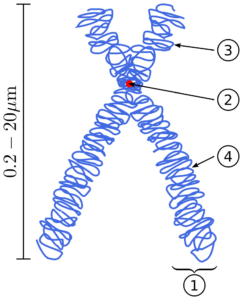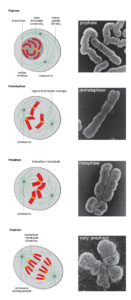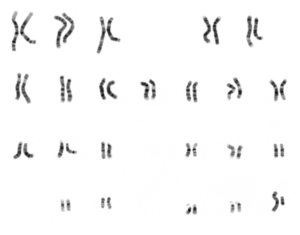Chromosome structure refers to the way that the chromatin fibers are compacted in the cell.
Long strands of DNA holding genetic information make up chromosomes. Eukaryotic chromosomes are significantly bigger than prokaryotic chromosomes and are linear chromosomes.
The DNA condenses into chromosomes after replication. After replication, each chromosome is made up of a collection of a duplicate set of chromatids usually held together at the centre by a centromere. The centromere is where the kinetochore (a protein structure that connects the spindle fibres), attaches to the centromere, which pulls the sister chromatids to 2 opposites of the cell after chromatin division.
Below we will explain the chromosome structure in detail.
What are chromosomes?
A chromosome is referred to the compacted DNA molecule found in an organism carrying its genetic information.
Chromosomes are thread-like structures found in all organisms(prokaryotes, eukaryotes but not viruses) that carry and deliver genetic information. Each chromosome is made up of one molecule of protein and one molecule of deoxyribonucleic acid (DNA), but it can occasionally also be RNA.

Image: Wikipedia
DNA is passed along from one generation to the next and carries the precise instructions and information that distinguish each living thing from the other. Viral chromosomes differ from those of prokaryotes and eukaryotes in both shape and position.
DNA (deoxyribonucleic acid) (chromosomes of nonliving viruses) and RNA (ribonucleic acid) (chromosomes of prokaryotic organisms like bacteria and blue-green algae) are the only varieties of chromosomes that are capable of replication. Since prokaryotes do not have a nucleus their chromosomal material is not surrounded by any sort of membranous structure.

Chromosomal Function:
- DNA structure is basically like long threads, hence for compactness and easy handling by the cell itself they are spooled around some circular proteins called histones.
- If DNA molecules were not packed in this fashion, it would be impossible for a cell to hold all its genetic material within itself.
- For example, if we laid out the entire human genome and unreeled it from the histone proteins, it would extend 6 feet when laid end-to-end.
- It’s critical for DNA to be intact and dispersed uniformly throughout cells during cell division.
- In the great majority of cell divisions, chromosomes play an important role in ensuring that DNA is appropriately copied and distributed.
- Each eukaryotic organism has a specific number of chromosomes, that determines its features, development and life.
- During asexual reproduction, all of the organism’s cells, including its gametes, contain the same number of chromosomes.
- Somatic cells in the body are generally diploid (2n), i.e., they have a set or sets of paired chromosomes. On the other hand cells like gametes are what we call haploid (n), as they contain half of the chromosomal pairs. Gametes are normally produced by meiosis.
- Meiosis produces haploid cells or gametes, containing one chromosome of a pair. When the two gametes join during fertilisation forming a zygote, the cell again becomes diploid having a pair of chromosomes.
Chromosome structure in bacterial cells:
Because of their tiny size, bacterial chromosomes were found considerably later than their eukaryotic counterparts. Furthermore, unlike eukaryotic chromosomes, bacterial chromosomes do not go through the dramatic metaphase condensation that makes eukaryotic chromosomes so visible.

Image: Wikipedia
Most bacterial chromosomes (also called genophores)can range from a mere 13,0000 base pairs to more than 14,000,000 base pairs depending on the size and complexity of the prokaryote. Nuclei are not seen in prokaryotes. Instead, their DNA is structured into a nucleoid-like structure. The nucleoid is a separate structure within the bacterial cell that occupies a specific area.
This structure, on the other hand, is dynamic and is maintained and reshaped by a group of histone-like proteins that connect with the bacterial chromosome. The DNA in archaea’s chromosomes is much better ordered, with DNA wrapped in structures akin to eukaryotic nucleosomes.
Chromosome structure in plant cells:
For plants in most angiosperm species, the chromosomal structure consists of a centromere (primary constriction) made up of condensed chromatin regions bordered by pericentromeric areas rich in heterochromatin and telomeres that mark the ends of chromosomes.
The differential condensation pattern during the prometaphase/metaphase stage may often be used to identify individual chromosomes. Most higher organisms’ DNA is made up of repetitive DNA sequences. Various groups of repeated elements scatter throughout the genome in different ways; they might form distinct territories, such as NORs or centromeres, or they can be dispersed within a chromosome or across the genome.
Chromosome structure in animal cells:
Multiple big linear chromosomes are housed in the nucleus of eukaryotes. Each chromosome has one centromere and one or two arms that protrude from it, albeit these arms are rarely visible unless in the division phase. Eukaryotes can also have a mitochondrial genome, which can be linear or circular in nature, however, they do not participate in inheritance.
Among all eukaryotic chromosomes those in mammals, more specifically in humans is the most in number and also the most complex. Autosomes (body chromosomes) and allosomes (sex chromosomes) are the two kinds of chromosomes found in humans. Sex chromosomes pass on some genetic features that are connected to a person’s sex.
The autosomes hold the rest of the relevant and necessary genetic information. They all behave in the same way during cell division, because the autosomes are all clones of each other. Human cells have 46 chromosomes, including 22 pairs of autosomes and one pair of sex chromosomes or allosomes.
The main difference in the male and female chromosomal constitution is simply the difference in the final pair of chromosomes also called the allosomes. While females have the chromosomal structure of 44 autosomes+ XX allosomes, the male chromosomal composition is 44 autosomes+ XY allosomes.

Image: Wikipedia
As females have only one type of allosome, all eggs produce have the same X allosomes. The gender of the fetus is determined by the X or Y chromosome present in the sperm that fertilizes the egg. Sperm with a Y chromosome produces a boy (XY) while one with an X produces a girl (XX).
Also Read:
- Filamentous bacteria examples
- Unsaturated fat examples
- Non pathogenic bacteria examples
- Do white blood cells have a nucleus
- Are bacteria pathogens
- Flagship species examples
- Are bacteria prokaryotes
- Spiral bacteria examples
- Is enzyme inhibited
- Channel proteins

I am Trisha Dey, a postgraduate in Bioinformatics. I pursued my graduate degree in Biochemistry. I love reading .I also have a passion for learning new languages.
Let’s connect through linked in: